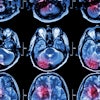
The U.K. Royal College of Radiologists (RCR) has published new standards that a radiology department should meet when integrating artificial intelligence (AI) into an established PACS or RIS. The aim is to produce a safe, seamless system in which the patients' needs are of paramount importance.
The main recommendations of the 10-page document are as follows:
- AI must be integrated in reporting workflows in a way that does not add extra burden to radiologists.
- The accuracy of the AI algorithms must be clearly declared for radiologists and others making decisions on patient management.
- AI findings must be communicated to the RIS via existing, widely used global technical standards (HL7).
- AI findings must be communicated to the PACS using existing, widely used global technical standards (DICOM).
- The workflow must be robust enough to ensure AI analysis is complete and available on PACS before a human reporter starts image interpretation.
 Dr. Neelam Dugar from Doncaster, U.K.
Dr. Neelam Dugar from Doncaster, U.K."Careful analysis of the reporting workflow and understanding of interoperability standards are essential," noted Dr. Neelam Dugar, chair of the RCR's Radiology Informatics Committee and a member of AuntMinnieEurope.com's editorial advisory board, and her colleagues. "It is hoped that this guidance will support radiologists who are involved in AI procurement in their departments."
The guidelines are limited to the inclusion of AI for image analysis. They do not advise radiologists which AI algorithm solution they should buy, and they neither advise on the ethical issues around the use of AI nor discuss AI solutions for workflow and radiology management efficiency, they added.
"Radiologists will continue to hold medicolegal responsibility for image interpretation," they stated. "The technology will enhance the reporting workflow for radiologists in two ways: medical image analysis, providing computer pre-analysis of radiology images to help detect and classify abnormalities on images; and computer-assisted triage, helping with prioritisation of reporting worklists when an abnormality is detected by AI."
A declaration must accompany every computer-generated analytic report about its limitations, and it is vital that all doctors are mindful of the limitations and do not consider computer-generated reports to be 100% accurate all the time, the authors continued.
A vendor must provide simple guidance on the meaning of sensitivity and specificity for doctors using the system, and this should be related to the particular AI algorithm with specific examples. Each time an AI package is adopted, it must be accompanied by a clinically specific document that describes what the specificity and sensitivity means in the context of the particular pathology.
“This is about the human interface of technology adoption and mitigating risks to patients,” they pointed out.
Impact of AI on patient care
AI will play a significant role in the way clinical radiology will be delivered in the future, writes Prof. Mark Callaway, the RCR's medical director for professional practice, in the foreword of the document.
"It will change the way that radiologists and imaging teams work. It will change how we are able to care for our patients. In light of this, it is critical that these new and emerging technologies are integrated into established reporting systems in a safe manner that allows the benefits to be maximized and delivered in a safe a consistent manner," he stated.
The document is the beginning of an evolutionary pathway of guidance as AI becomes increasingly integrated into traditional clinical radiology working patterns, and it sets the standards on how this can best be achieved, according to Callaway.
The document can be downloaded free-of-charge from the RCR website.



















